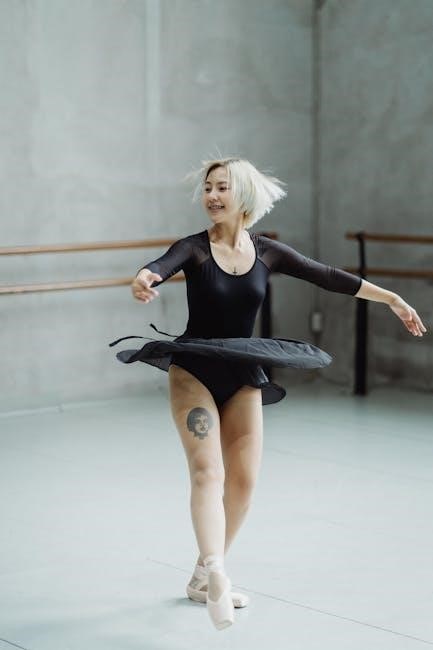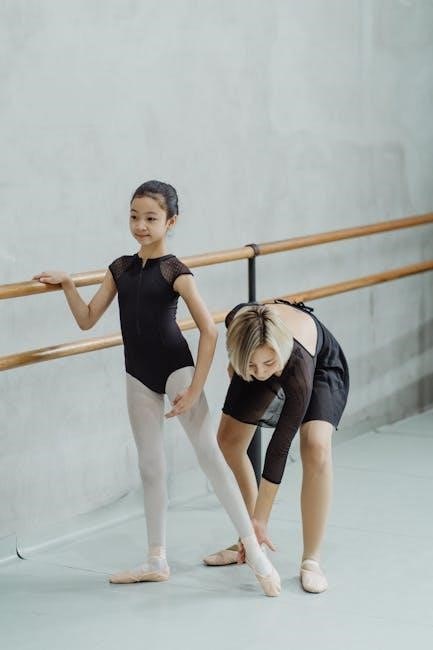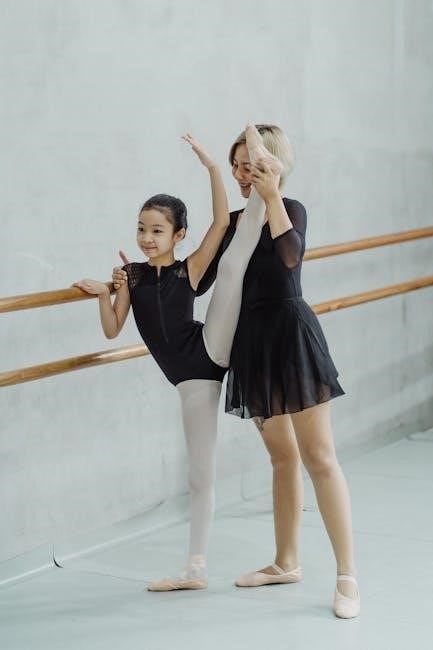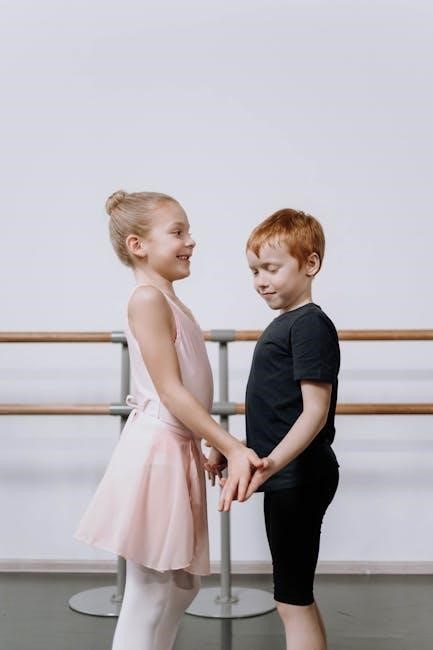Ballet barre exercises, rooted in decades of dance training, have surged in popularity as a fitness trend, offering a unique blend of strength and grace․
Inspired by classical ballet, these workouts utilize a barre – a stationary handrail – for support, drawing from Pilates, yoga, and strength training․
Originally developed by Lotte Berk in the 1950s, barre provides a low-impact, full-body workout, enhancing posture, flexibility, and muscle endurance for all levels․
What is a Ballet Barre Workout?
A ballet barre workout is a fitness class inspired by the techniques used by ballet dancers to warm up and strengthen their bodies․ However, you don’t need any dance experience to participate! These workouts typically involve a series of small, controlled movements performed at a barre – or a stable chair – for support․
Unlike traditional ballet classes focused on choreography, barre prioritizes isometric strength training and high repetitions․ This method effectively targets specific muscle groups, particularly in the legs, glutes, core, and arms․ The focus is on precision and form, ensuring muscles are engaged throughout each exercise․
Barre workouts incorporate elements from Pilates, yoga, and strength training, creating a comprehensive, low-impact routine․ Expect to hold poses for extended periods, feeling the “burn” as muscles fatigue and strengthen․ It’s a fantastic way to improve posture, flexibility, and overall body tone, making it accessible and beneficial for all fitness levels․

The History of Barre: Lotte Berk’s Influence
The origins of barre can be traced back to the 1950s and a German dancer named Lotte Berk․ Fleeing Nazi Germany, Berk combined her ballet training with rehabilitative exercises learned while recovering from a back injury․ This fusion led to the creation of a unique workout method in London․
Berk’s technique focused on isometric exercises – holding muscles in contraction – combined with ballet-inspired movements at the barre․ She emphasized small, precise movements to fatigue muscles quickly, building strength and endurance․ Her classes attracted a devoted following, including celebrities and members of the royal family․
While Lotte Berk’s method remained relatively niche for decades, it gained significant traction in the United States in the 21st century․ Several studios emerged, adapting and popularizing her original principles․ Today, barre continues to evolve, but its foundation remains rooted in Berk’s innovative approach to fitness․

Benefits of Incorporating Barre into Your Fitness Routine
Barre workouts offer a comprehensive range of physical and mental benefits, making them a valuable addition to any fitness routine․ The low-impact nature of barre makes it accessible to individuals of all ages and fitness levels, minimizing stress on joints while maximizing results․
Regular barre practice improves posture, strengthens core muscles, and enhances flexibility․ The focus on precise movements cultivates body awareness and muscle control․ Furthermore, barre can increase endurance, tone muscles, and promote a leaner physique․
Beyond the physical advantages, barre can also reduce stress and improve mental focus․ The combination of mindful movement and challenging exercises fosters a sense of accomplishment and well-being․ It’s a holistic approach to fitness that benefits both body and mind․
Essential Ballet Barre Exercises
Ballet barre exercises form the foundation of technique, focusing on precise movements like pliés, tendus, and dégagés to build strength and flexibility․
Pliés: The Foundation of Ballet
Pliés, meaning “bends” in French, are arguably the most fundamental exercise in ballet barre work, serving as the cornerstone for all other movements․ They are performed by bending the knees while maintaining proper posture and turnout․
There are two main types of pliés: demi-plié (half bend) and grand plié (full bend)․ Demi-pliés are smaller, quicker bends used for warming up and developing coordination, while grand pliés involve a deeper bend, strengthening the legs and improving flexibility․
Correct plié execution emphasizes keeping the back straight, the core engaged, and the weight evenly distributed across the feet․ This exercise builds strength in the legs, glutes, and core, while also improving ankle flexibility and preparing the body for more complex ballet movements․ Mastering the plié is crucial for safe and effective barre training․
Tendus: Developing Leg Extension and Control
Tendus, translating to “stretched” in French, are a vital ballet barre exercise focused on extending the leg while maintaining precise control and articulation of the foot․ This movement emphasizes lengthening through the leg, pointing the toes, and engaging the core for stability․
Performed by sliding the foot along the floor to a fully extended position and then returning, tendus build strength and flexibility in the legs, ankles, and feet․ They also refine coordination and improve the dancer’s awareness of proper alignment․
Focus is placed on maintaining turnout from the hip, keeping the hips square, and avoiding sickling or winging of the foot․ Tendus are often practiced in all five ballet positions, progressively challenging the dancer’s technique and control․ Consistent practice enhances leg strength and prepares the body for more advanced steps․
Dégagés: Refining Footwork and Precision
Dégagés, meaning “disengaged” in French, are a fundamental ballet barre exercise designed to refine footwork, precision, and articulation․ Unlike tendus which slide along the floor, dégagés involve a swift, brushing movement where the foot leaves the floor slightly․
This exercise focuses on maintaining a pointed foot, strong core engagement, and precise control throughout the movement․ The leg extends to a fully stretched position, and the foot “disengages” from the floor with a quick, clean motion before returning to the starting position․
Dégagés build strength in the feet and ankles, improve coordination, and enhance the dancer’s ability to execute clean, articulate movements; Practiced in all five ballet positions, they demand attention to detail and contribute to overall technical proficiency․
Rond de Jambe: Enhancing Hip Mobility
Rond de Jambe, translating to “round of the leg” in French, is a crucial ballet barre exercise focused on developing hip mobility, flexibility, and leg strength; Performed while holding the barre for support, it involves a circular movement of the working leg․
There are two primary types: à terre (on the ground) and en l’air (in the air)․ Rond de Jambe à terre keeps the foot on the floor as the leg traces a semi-circular path, while en l’air elevates the leg, maintaining the circular motion․
This exercise strengthens the outer and inner thighs, improves hip joint range of motion, and enhances coordination․ Maintaining proper posture, a stable core, and a consistent turnout are essential for maximizing benefits and preventing injury․ It’s a cornerstone for more advanced ballet techniques․
Frappés: Strengthening Leg Muscles

Frappés, meaning “struck” in French, are dynamic ballet barre exercises designed to rapidly strengthen and tone the leg muscles, particularly the thighs, glutes, and calves․ This exercise involves a quick, brushing movement of the foot along the floor, extending and retracting the leg․
Starting with the foot wrapped (enveloppé) and pointed, the leg extends outwards with a sharp, precise motion, then quickly returns to the wrapped position․ Maintaining a strong core and proper alignment is vital throughout the exercise․
Frappés improve articulation of the foot, enhance leg control, and build muscular endurance․ Variations include frappé devant (front), frappé à la seconde (side), and frappé derrière (back), targeting different muscle groups․ Consistent practice refines technique and builds leg strength․

Intermediate Ballet Barre Exercises
Intermediate barre builds upon foundational movements, introducing more complex combinations demanding greater strength, flexibility, and control, refining technique and artistry․
Fondu: Combining Plié and Leg Extension
Fondu, a cornerstone of intermediate ballet barre work, elegantly merges the foundational plié with a controlled leg extension, demanding both strength and fluidity․ This exercise begins in a plié position, and as you straighten the working leg, the supporting leg simultaneously deepens its plié, creating a melting – or ‘fondu’ – effect․

The key lies in coordinating the bending and straightening of the legs, maintaining a stable core and upright posture throughout the movement․ Fondu isn’t simply about lifting the leg; it’s about the harmonious relationship between the two legs and the engagement of stabilizing muscles․
Variations include fondu devant (to the front), à la seconde (to the side), and derrière (to the back), each challenging different muscle groups and enhancing coordination․ Proper execution improves leg strength, ankle stability, and overall balance, preparing dancers for more advanced steps․
Adagio at the Barre: Developing Slow, Controlled Movements
Adagio at the barre represents a crucial step in intermediate ballet barre training, focusing on sustained, slow, and controlled movements; This exercise sequence typically combines pliés, tendus, and dégagés, performed with deliberate precision and a continuous flow of energy․
The emphasis isn’t on speed or height, but on maintaining perfect alignment, engaging the core, and controlling every muscle throughout each movement; Adagio cultivates a deep awareness of body placement and promotes graceful transitions between positions․
It’s a powerful tool for developing strength, flexibility, and artistry, demanding intense concentration and muscular endurance․ Instructors often cue breath synchronization to enhance control and fluidity․ Mastering adagio builds the foundation for more complex ballet combinations and improves overall technique․
Grands Battements: Increasing Range of Motion
Grands battements at the barre are a cornerstone of advanced ballet barre work, specifically designed to dramatically increase leg extension and overall range of motion․ These large, sweeping kicks require significant flexibility, strength, and control, challenging dancers to fully articulate their legs․
Executed with a turned-out position, grands battements emphasize maintaining proper alignment of the hips and spine while achieving maximum height․ The exercise is performed slowly and deliberately, focusing on the quality of the movement rather than simply reaching for height․
Consistent practice improves flexibility in the hamstrings, hip flexors, and adductors․ It also strengthens the core and leg muscles, contributing to improved technique and preventing injuries․ Proper form is crucial to avoid strain and maximize benefits․
Advanced Ballet Barre Exercises & Considerations
Advanced barre work demands precise technique, deep core engagement, and focused turnout training, building upon foundational exercises for optimal strength and artistry․
Turnout Training for Ballet

Turnout, a hallmark of ballet technique, originates from the hips, not the knees or ankles, and is crucial for executing many barre exercises effectively․ Achieving proper turnout requires consistent, mindful training, focusing on external rotation of the legs while maintaining a stable pelvis․
Beginners should avoid forcing turnout, as this can lead to injury; instead, prioritize strengthening the deep external rotators – muscles like the piriformis – through targeted exercises․ Barre work provides an ideal setting for developing turnout gradually, utilizing pliés, rond de jambe, and fondu to encourage hip mobility․
It’s essential to remember that individual anatomy dictates the extent of achievable turnout; pushing beyond one’s natural range is counterproductive․ Focus on quality of movement over quantity, and always listen to your body, incorporating stretches and warm-ups to prepare the muscles for work․ Consistent practice, combined with proper alignment, will yield the best results in turnout development․
Core Engagement in Barre Exercises
Core engagement is paramount in ballet barre exercises, acting as the foundation for stability, control, and efficient movement throughout the entire body․ Think of your core – encompassing abdominals, back muscles, and pelvic floor – as a natural corset, providing support and preventing injury․

Maintaining a “pulled-up” core, as dancers say, involves gently drawing the navel towards the spine and activating the transverse abdominis․ This subtle engagement should be sustained throughout each exercise, from pliés to grands battements, preventing excessive arching or rounding of the back․
A strong core not only enhances technique but also protects the spine and improves posture․ Exercises like pelvic tilts and gentle abdominal contractions can be incorporated as warm-ups to prime the core muscles․ Remember, core engagement isn’t about forceful tightening, but rather a consistent, subtle activation that supports every movement․
Finding Ballet Barre Exercise PDFs and Resources
Numerous online resources offer ballet barre exercise PDFs and guidance for practitioners of all levels․ A simple web search using keywords like “ballet barre workout PDF,” “barre exercise sequence,” or “printable barre routine” yields a wealth of options․
Websites dedicated to fitness and dance often provide free downloadable PDFs outlining specific exercises, sequences, and modifications․ Platforms like YouTube also host countless ballet barre tutorials, offering visual demonstrations and step-by-step instructions․

Consider exploring resources from certified barre instructors and studios, as they often share sample workouts or introductory materials․ Be mindful of the source’s credibility and prioritize resources that emphasize proper form and safety․ Remember to always listen to your body and modify exercises as needed․
Modifications for Beginners
Starting a ballet barre workout can be intimidating, but numerous modifications make it accessible for beginners․ If full range of motion is challenging, reduce the depth of pliés or the height of leg extensions․ Utilizing a chair for additional support can aid balance during exercises like rond de jambe or tendus․

Focus on mastering proper form before increasing intensity or repetitions․ Beginners can also modify grand battements by keeping the leg lower and concentrating on controlled movements․ Don’t hesitate to take breaks when needed and listen to your body’s signals․
Many ballet barre exercise PDFs offer beginner-friendly variations, and online tutorials often demonstrate modifications․ Prioritize building a solid foundation of strength and technique before progressing to more advanced exercises․
Safety Precautions and Proper Form
Maintaining proper form is paramount in ballet barre exercises to prevent injuries․ Always warm up muscles before starting, focusing on dynamic stretches․ Engage your core throughout each exercise to stabilize the spine and protect the lower back․ Avoid locking your knees and maintain a slight bend․
Listen to your body and stop if you experience any pain․ A ballet barre exercise PDF should illustrate correct alignment for each movement; utilize these resources․ Ensure adequate space around the barre to prevent collisions․
Beginners should start slowly and gradually increase intensity․ Proper footwear, like socks or ballet shoes, provides grip and support․ Consulting a qualified instructor is recommended, especially when learning new exercises, to ensure safe and effective practice․